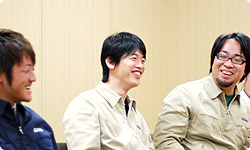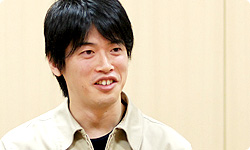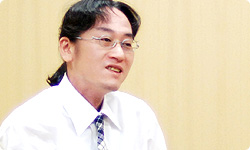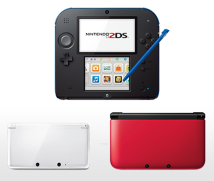3. Improving Durability
Akai-san, why did you think it was impossible?
I thought we could make a few, but to mass produce it would be...
We have made several million in a month - for all Nintendo DS models combined - during the peak period before the year-end shopping season, but there are some manufacturing limitations in doing that.
Yes. We are asking several facilities in China to do the mass production, but only a limited number of manufacturing facilities are technologically capable of certain special processes, so producing millions per month would be impossible.
That can sometimes cause a considerable restraint for Nintendo’s industrial designers.
Yes. Products with highly unusual design can be manufactured if the amount of the total production is relatively small, like mobile phones with a variety of different designs but with small production runs for each - but Nintendo’s first priority is whether or not its products can be mass-produced.
After settling on a design, the baton was passed to the mechanical design team. What did you think at that time, Goto-san?
I thought, “Oh, this is the last one I wanted!”
Of the three proposals, we had chosen the design that was the most difficult. (laughs)
Exactly. (firmly)
(laughs)

Ehara-san just said that he wasn’t sure if we could make it, and we weren’t either. When I explained it at the Uji Plant, I could draw an illustration and say, “This is what we have to make,” but I thought, “How are we supposed to do that?”
When I heard your explanation, I asked, “How do we make it?” and you answered...
I said, “We’re looking into it.” (laughs)
You didn’t know how to make it, but you said, “We’re looking into it.” (laughs) Akai-san, when did you move to the development team?
January 2010.
So you were told to join just when development was about to kick into high gear?
Yes. I plunged into a situation I had said was impossible.
Well, you couldn’t say that anymore! (laughs)
Yeah, so I panicked. (laughs)
What was the first obstacle?
First, we had to figure out how to handle the top layer. We tried a lot of things before getting the right distinctive texture and reverse taper. We ended up considering a lot of special processes and configurations and a way to mass-produce it became clear, but then we began to worry about quality, about whether it would break when dropped.
The reverse taper was designed so the system would be easy to open, but if something hit it, all the force would hit one place, so it had a drawback when it came to durability against impact from dropping.
Right.
I thought the shape might have to change.
You talked about that during the second presentation.
Yes.
But we didn’t want to change the design, so we searched for a stronger synthetic resin.
You instinctively knew that you couldn’t produce that design unless you found a stronger material.
Yes. Looking for a new material was the first thing I did after moving to the Research & Engineering Department.

And what did you come up with?
A material Nintendo has never used before. A type of high-rigidity nylon with glass fibre in it. It’s stronger than other more common resins, but less suited to mass production.
It does sound like it would be difficult to shape.
It is. You fill the metal mould7 with the resin to shape it, but it’s tough because of the glass fibre in it. As you repeat the process, the mould begins to wear, so we were concerned the lifespan of the mass-production equipment would be shortened. 7Metal mould: A container in an inverted form of the shape you want to cast. They are often made of metal. Plastic and other materials are poured into them for mass production.
You can’t really judge something like that without making the actual stuff.
Exactly. Until now, we’ve had a test mould made for use in verification, but I thought the schedule was too tight to wait for that. Extra moulds left over from past machines were around, so we used those for verification.
Ah, I see! You decided to test it out using moulds for products that aren’t often manufactured anymore.
Right.
How many types did you try?
We tested all kinds of materials - not just the high-rigidity nylon resin, but over ten resins. There were so many samples sitting around that I didn’t have a place to put them anymore!
You repeatedly made samples with various materials and tested their strength and confirmed their manufacturability.
Yes. As a result, we found an excellent resin, and then learned that even using the best possible resin, if you dropped it, it broke.
It would break even with the strongest resin?
Yes. So I consulted the mechanical design team and we addressed the problem by changing the internal thickness, considering a change of the internal shape to strengthen it, and so on.
So, these approaches were made from the point of view of materials. What difficulties did you run into with regard to the mechanism?
There were a lot, but the hardest thing was strengthening the hinge.8 8Hinge: The part of the Nintendo 3DS system connecting the upper and lower portions and allowing it to open and close.

Yes, that’s right.
It bears the brunt of a lot of pressure because the system is continually opened and closed. What’s more, it’s on the edge, so it gets hit a lot when dropped and is easily breakable, so it was a challenge figuring out how to strengthen it.
Yes. If we got past one problem and there was a change in the designs or conditions regarding another part, then another problem would arise.
Even the smallest change could have an influence on something else, forcing you to do it all over again.
Yes. Once we got past something, another problem would arise. And we just kept repeating that cycle.
How long was your fight to solve the problem of strengthening the hinge?
Quite long.
I think we tackled it toward the end of February 2010 and began coming to terms with it around the end of August.
You battled with that hinge for half a year!
Yeah. Everyone involved tested it up until the very end.
